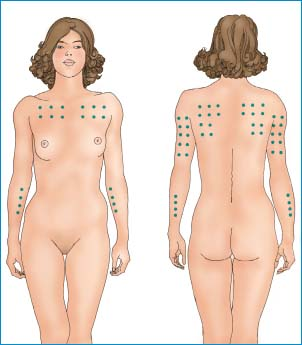Intradermal Injection
Because little systemic absorption of intradermally injected agents takes place, this type of injection is used primarily to produce a local effect, as in allergy or tuberculin testing. Intradermal injections are administered in small volumes—usually 0.1 mL or less—into the outer layers of the skin.
The ventral forearm is the most commonly used site for intradermal injection because of its easy accessibility and lack of hair. In extensive allergy testing, the outer aspect of the upper arms may be used, as well as the area of the back located between the scapulae. (See Intradermal injection sites, page 410.)
Equipment
Patient’s medication record and chart ▪ tuberculin syringe with a 26G or 27G ½″ to 3/8″ needle ▪ prescribed medication ▪ gloves ▪ alcohol pads ▪ gauze pads ▪ pen, if needed.
Implementation
Verify the doctor’s order for the prescribed drug, dosage, and route.1 Compare the order with the drug label.
Intradermal Injection Sites
The most common intradermal injection site is the ventral forearm. Other sites (indicated by dotted areas) include the upper chest, upper arm, and shoulder blades. Skin in these areas is usually lightly pigmented, thinly keratinized, and relatively hairless, facilitating detection of adverse reactions.
 |
Review the patient’s medical record for drug allergies.1
Avoid distractions and interruptions when preparing and administering the medication to prevent medication errors.2
Check the prescribed medication for color and clarity, observe for abnormal changes, and note the medication’s expiration date.3 If the medication has expired, return it to the pharmacy and obtain a new vial.
Select the appropriately sized needle.
Confirm the patient’s identity using at least two patient identifiers according to your facility’s policy.7
Stay updated, free articles. Join our Telegram channel

Full access? Get Clinical Tree


Get Clinical Tree app for offline access
